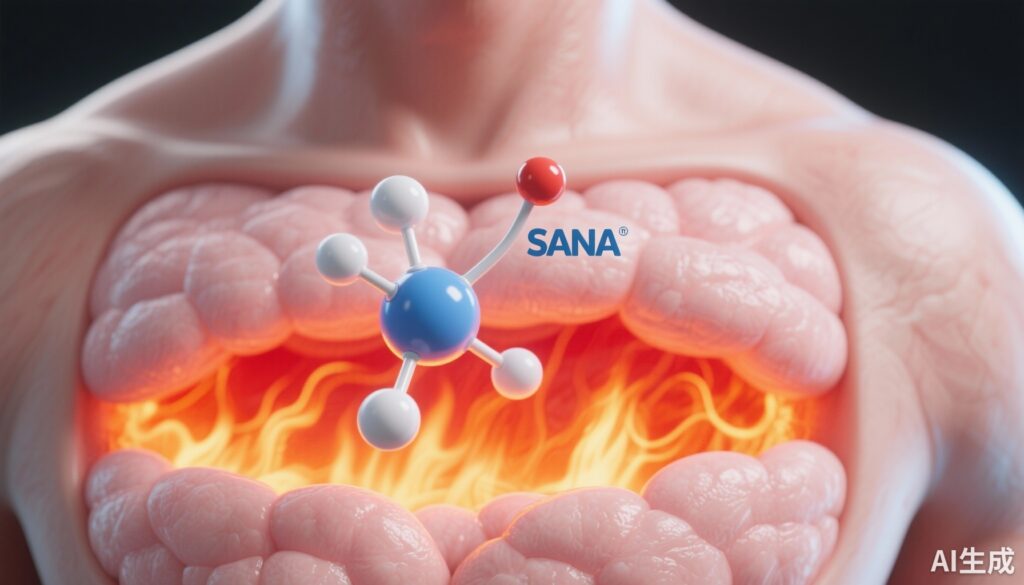Study Background and Disease Burden
Obesity and its related complications such as insulin resistance, type 2 diabetes, and non-alcoholic fatty liver disease constitute a major global health burden, affecting millions worldwide. Despite notable advances, including glucagon-like peptide-1 (GLP-1) receptor agonists that have revolutionized obesity pharmacotherapy, additional therapeutic agents are needed to complement existing strategies and address residual unmet needs. Innovative drug discovery approaches have focused on small molecules that target metabolic pathways modulating energy expenditure and adipose tissue function, with potential to improve weight management and metabolic health.
Study Design
Through phenotypic drug discovery, researchers developed a nitroalkene-containing salicylate derivative named SANA (5-(2-nitroethenyl)salicylic acid). The preclinical efficacy and safety of SANA were evaluated in mice with diet-induced obesity (DIO). Analyses included measures of body composition, glucose management, liver histology, and energy metabolism under various conditions.
Subsequently, a randomized, double-blind, placebo-controlled phase 1A/B clinical trial (Australian New Zealand Clinical Trials Registry ACTRN12622001519741) was conducted. The trial involved two parts: single ascending doses (200-800 mg) in healthy lean volunteers and multiple ascending doses (200-400 mg daily for 15 days) in volunteers with overweight or obesity. Primary endpoints included safety and tolerability, with secondary and exploratory endpoints covering pharmacokinetics, body weight, and metabolic markers.
Key Findings
Preclinical Efficacy and Mechanism
SANA demonstrated potent protection against diet-induced obesity in mice, markedly reducing fat accumulation across adipose depots while sparing lean mass. This weight modulation was independent of changes in food intake, energy absorption, or locomotor activity. SANA was synthesized efficiently with ~93% yield and exhibited pharmacokinetic properties indicating rapid absorption (Tmax at 0.5 h) and clearance within 24 h post-oral administration.
Mechanistically, SANA enhanced mitochondrial respiration and stimulated creatine-dependent thermogenesis in adipose tissue, a process distinct from classical uncoupling protein 1 (UCP1) mediated pathways and independent of AMP-activated protein kinase (AMPK) activity. Thermal imaging and adipose tissue histology revealed increased surface temperatures and a beige adipocyte phenotype with reduced lipid droplet size, consistent with enhanced energy expenditure.
In the liver, SANA prevented steatosis and normalized liver weight in mice fed a high-fat diet. Plasma liver transaminase levels, markers of liver damage, were fully protected. Improved glucose tolerance, lower fasting glucose, reduced insulin secretion, and enhanced insulin sensitivity (confirmed by HOMA-IR) were noted in SANA-treated animals compared to obese controls and those treated with salicylate alone.
Importantly, SANA also therapeutically reduced established obesity and metabolic derangements when administered after obesity onset, outperforming both salicylate and metformin in improving glycemic control over a 3-week period.
Safety and Pharmacokinetics in Humans
In the phase 1A/B clinical trial enrolling lean volunteers and subjects with overweight or obesity, SANA (also designated MVD1) was well tolerated. Only two adverse events likely related to the drug were reported, both reversible renal tubular damages at the highest single dose. No severe adverse events occurred, and liver function tests remained normal. Pharmacokinetic profiles demonstrated similar absorption and clearance patterns as observed in mice, with no evidence of drug accumulation after 15 days of multiple dosing.
Exploratory endpoints suggested weight reduction and improved glucose parameters within just 2 weeks of SANA administration.
Expert Commentary
SANA represents a novel therapeutic candidate targeting creatine-dependent thermogenic pathways in adipose tissue, an alternative to traditional UCP1-dependent mechanisms. The compound’s ability to activate mitochondrial respiration and energy expenditure without affecting appetite or physical activity is particularly promising for obesity management. Its efficacy in both preventing and reversing diet-induced metabolic dysfunction in animal models supports translational potential.
While phase 1 data indicate favorable safety and initial metabolic benefits, larger, longer-term trials are necessary to confirm efficacy and safety, particularly regarding renal effects observed at higher doses. Further mechanistic studies will elucidate the precise molecular interactions of SANA and its influence on adipocyte metabolism.
Conclusion
SANA, a nitroalkene derivative of salicylate, emerges as a first-in-class activator of creatine-dependent thermogenesis and a promising pharmacologic agent against obesity and its metabolic complications. Preclinical and early clinical data demonstrate its capacity to induce weight loss, reduce hepatic steatosis, and improve insulin sensitivity without detrimental safety signals. This novel mechanism might offer an important complement to existing pharmacotherapies for ‘diabesity’. Ongoing and future clinical trials will be key to establishing its role in clinical practice.
References
Cal K, Leyva A, Rodríguez-Duarte J, et al. A nitroalkene derivative of salicylate, SANA, induces creatine-dependent thermogenesis and promotes weight loss. Nat Metab. 2025;7(8):1550-1569. doi:10.1038/s42255-025-01311-z.
Additional sources:
1. Garvey WT, Mechanick JI, Brett EM, et al. American Association of Clinical Endocrinologists and American College of Endocrinology comprehensive clinical practice guidelines for medical care of patients with obesity. Endocr Pract. 2016;22(Suppl 3):1-203.
2. Kir S, Spiegelman BM. Cachexia & Brown Fat: A Burning Issue in Cancer. Trends Endocrinol Metab. 2016;27(6):322-332.



